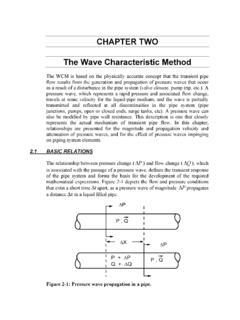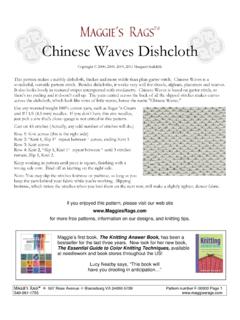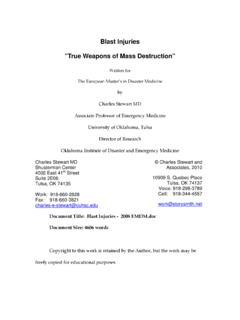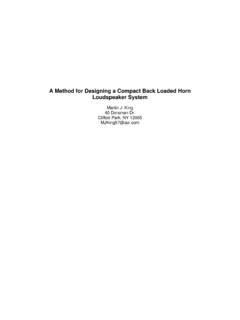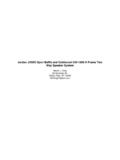Transcription of 'Sine Wave Oscillator' - TI.com
1 Application ReportSLOA060 - March 20011 sine -Wave OscillatorRon Mancini and Richard PalmerHPL (Dallas)ABSTRACTThis note describes the operational amplifier (op-amp) sine -wave oscillator, together with thecriteria for oscillation to occur using RC components. It delineates the roles of phase shift andgain in the circuit and then discusses considerations of the op amp. A brief analysis of aWien-Bridge oscillator circuit is provided. Several examples of sine -wave oscillators aregiven, although it is recognized that there exist many additional types of oscillator to whichthe principles of this application note also.
2 2 sine -Wave Oscillator Defined3.. 3 Requirements for Oscillation3.. 4 Phase Shift in the Oscillator5.. 5 Gain in the Oscillator6.. 6 Effect of the Active Element (Op Amp) on the Oscillator7.. 7 Analysis of Oscillator Operation (Circuit)8.. 8 sine -Wave Oscillator Circuits10.. Wein-Bridge Oscillator10.. Phase-Shift Oscillator, Single Amplifier14.. Phase-Shift Oscillator, Buffered16.. Bubba Oscillator17.. Quadrature Oscillator18.. 9 Conclusion19.. 10 References20.. List of Figures1 Canonical Form of a System With Positive or Negative Feedback4.
3 2 Phase Plot of RC Sections5.. 3 Op-Amp Frequency Response7.. 4 Distortion vs Oscillation Frequency for Various Op-Amp Bandwidths8.. 5 Block Diagram of an Oscillator9.. 6 Amplifier With Positive and Negative Feedback9.. 7 Wein-Bridge Circuit Schematic10.. Trademarks are the property of their respective Oscillator8 Final Wein-Bridge Oscillator Circuit11.. 9 Wein-Bridge Output Waveforms: Effects of RF on Distortion12.. 10 Wein-Bridge Oscillator With Nonlinear Feedback12.. 11 Output of the CIrcuit in Figure 1013.. 12 Wein-Bridge Oscillator With AGC14.
4 13 Output of the Circuit in Figure 1214.. 14 Phase-Shift Oscillator (Single Op Amp)15.. 15 Output of the Circuit in Figure 1415.. 16 Phase-Shift Oscillator, Buffered16.. 17 Output of the Circuit Figure 1616.. 18 Bubba Oscillator17.. 19 Output of the Circuit in Figure 1818.. 20 Quadrature Oscillator19.. 21 Output of the Circuit in Figure 2019.. SLOA0603 sine -Wave Oscillator1 IntroductionOscillators are circuits that produce specific, periodic waveforms such as square , triangular,sawtooth, and sinusoidal. They generally use some form of active device, lamp, or crystal,surrounded by passive devices such as resistors, capacitors, and inductors, to generate are two main classes of oscillator: relaxation and sinusoidal.
5 Relaxation oscillatorsgenerate the triangular, sawtooth and other nonsinuoidal waveforms and are not discussed inthis note. Sinusoidal oscillators consist of amplifiers with external components used to generateoscillation, or crystals that internally generate the oscillation. The focus here is on sine waveoscillators, created using operational amplifiers op wave oscillators are used as references or test waveforms by many circuits. A pure sinewave has only a single or fundamental frequency ideally no harmonics are present. Thus, asine wave may be the input to a device or circuit, with the output harmonics measured todetermine the amount of distortion.
6 The waveforms in relaxation oscillators are generated fromsine waves that are summed to provide a specified Oscillator DefinedOp-amp oscillators are circuits that are unstable not the type that are sometimesunintentionally designed or created in the lab but ones that are intentionally designed to remainin an unstable or oscillatory state. oscillators are useful for generating uniform signals that areused as a reference in such applications as audio, function generators, digital systems, andcommunication general classes of oscillators exist: sinusoidal and relaxation.
7 Sinusoidal oscillators consistof amplifiers with RC or LC circuits that have adjustable oscillation frequencies, or crystals thathave a fixed oscillation frequency. Relaxation oscillators generate triangular, sawtooth, square ,pulse, or exponential waveforms, and they are not discussed sine -wave oscillators operate without an externally-applied input signal. Instead, somecombination of positive and negative feedback is used to drive the op amp into an unstablestate, causing the output to cycle back and forth between the supply rails at a continuous frequency and amplitude of oscillation are set by the arrangement of passive and activecomponents around a central op oscillators are restricted to the lower end of the frequency spectrum because op ampsdo not have the required bandwidth to achieve low phase shift at high op amps are limited to a low kHz range because their dominant, open-looppole may be as low as 10 Hz.
8 The new current-feedback op amps have a much widerbandwidth, but they are very hard to use in oscillator circuits because they are sensitive tofeedback capacitance. Crystal oscillators are used in high-frequency applications up to thehundreds of MHz for OscillationThe canonical, or simplest, form of a negative feedback system is used to demonstrate therequirements for oscillation to occur. Figure 1 shows the block diagram for this system in whichVIN is the input voltage, VOUT is the output voltage from the amplifier gain block (A), and is thesignal, called the feedback factor, that is fed back to the summing junction.
9 E represents theerror term that is equal to the summation of the feedback factor and the input OscillatorVOUTA _ VIN+EFigure 1. Canonical Form of a Feedback System With Positive or Negative FeedbackThe corresponding classic expression for a feedback system is derived as follows. Equation 1 isthe defining equation for the output voltage; equation 2 is the corresponding error:VOUT+E AE+VIN)bVOUTE liminating the error term, E, from these equations givesVOUTA+VIN bVOUTand collecting the terms in VOUT yieldsVIN+VOUT 1A)b Rearrangement of the terms produces equation 5, the classical form of feedback expression:VOUTVIN+A1)AbOscillators do not require an externally-applied input signal.
10 Instead, they use some fraction ofthe output signal created by the feedback network as the input results when the feedback system is not able to find a stable steady-state because itstransfer function can not be satisfied. The system goes unstable when the denominator inequation 5 becomes zero, , when 1 + A = 0, or A = 1. The key to designing an oscillator isensuring that A = 1. This is called the Barkhausen criterion. Satisfying this criterion requiresthat the magnitude of the loop gain is unity with a corresponding phase shift of 180_ as indicatedby the minus sign.










